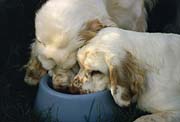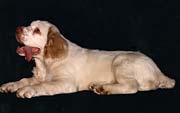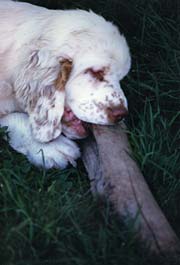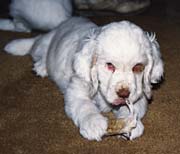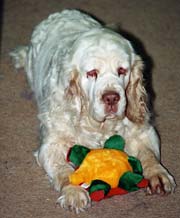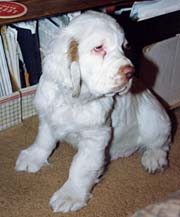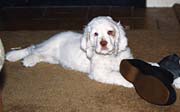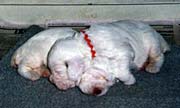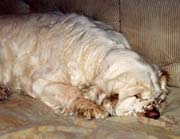Intervertebral disk disease is another health problem far too common in Clumbers. Most commonly this involves the cervical (neck) area, though it can also affect the thoraco-lumbar (back) area. This can be a devastating disease that causes extreme pain and/or paralysis. When it affects the back it tends to be more explosive as a disk suddenly ruptures and can cause instant paralysis in the rear end, though it tends to be less painful than when it affects the neck. Surgery is expensive and specialized but if done soon enough after the rupture, the paralysis can be reversed and the dog can go on to live relatively normally, though further inflammation or ruptures are always a concern as it's generally a degenerative problem involving the whole spine.
We have had first hand experience with thoraco-lumbar disk disease with our "Josie". She was diagnosed with disk disease at the age of 3, and less than a year later a disk ruptured at some point during the night as she slept in her crate and we discovered her paralyzed in the morning. We went ahead with surgery and, slowly, with lots of work at rehabilitation here at home, she began to regain feeling in her rear legs. 10 days after surgery she could walk on her own once again, and she continued to improve beyond our expectations. She never regained 100% feeling so she walked a bit funny, but she compensated wonderfully and got around as well as any of the other dogs. She had a few subsequent inflammatory episodes over the 6 years following surgery where the paresis returned, but with medication and enforced rest we got over these and she returned to functioning well. Unfortunately in the spring of 2001 the inflammation and paresis returned and the usual meds failed to work this time, and as a result of all the medication her kidneys ultimately shut down and we had to say goodbye to her at the age of almost 11.
As mentioned, cervical disk disease tends to be far more painful, and is usually more of a chronic progressive disease that affects older dogs, though it has also occurred in younger individuals. Initial signs can be as mild as stiffness or reluctance to turn or raise the head, or as severe as the dog flat out on the floor and screaming in pain if he moves even a little. Most commonly it starts out with occasional mild flare-ups that can be controlled with a course of Prednisone, then progresses to a more constant mild to moderately painful state that may be helped by a daily anti-inflammatory such as Metacam, and ultimately continues to progress to a constant state of more severe pain which medication no longer alleviates. It can also affect the front legs as the herniated disk presses on nerves and causes shooting pain and/or weakness down one or both front legs (and occasionally the rear legs as well.) Stumbling or falling can result due to the weakness as the dog essentially trips over his own feet, and this whole state is an extremely painful one for the dog. The good news (and yes there is some) is that surgery, although again expensive and specialized, is generally very successful at resolving the problem and allowing the dog to fairly quickly resume a normal and relatively pain free life.
We too have first hand experience with cervical disk problems with several of our Clumbers. Shane developed neck problems at just 7 1/2 years old, suddenly, severely, and without any prior signs. Unfortunately in his case an x-ray showed that the degeneration was very advanced and widespread throughout every disk in his neck, so he was not considered a candidate for surgery and we had to make the difficult decision to euthanize him at that point. Thomas developed the occasional bout of neck pain as he got older, but fortunately he would improve with a few weeks on Prednisone and then could be weaned off it and would be fine for anywhere from a few months to a year before his next flare-up. Paige began having neck problems at the age of 10 and things progressed fairly quickly. Prednisone would help, but as soon as she was weaned down below a certain level the pain would come back. Metacam was tried and seemed to do wonders for a few weeks, but after that the pain returned in full force. She began to have trouble walking as the pain ran down her legs and caused her muscles to constrict, and then she developed weakness in her legs and would trip over her feet and fall over if she turned too quickly. Since she was otherwise in good health and condition, and still retained such a determined spirit, we went ahead with surgery and she came through it with flying colours, happily walking out of the clinic without pain only a day and a half after surgery. Only one disk appeared to have herniated, and the other disks looked fine, so her prognosis for long term recovery was excellent. She was with us for another year, pain free and happy, until liver cancer suddenly claimed her life.
Entropion is another disorder all too common in the breed. In this condition the eyelids, either upper, lower, or both, roll inwards and cause irritation and scratching of the cornea. Severe cases can be seen even in 8 or 9 week old puppies, and surgery to correct the problem can be done at that time. More commonly though it is a milder problem that can't be fully diagnosed until the dog is an adult, though some vets will be eager to surgically correct the problem as soon as possible. Ideally in these mild cases the decision to undergo surgery should wait until the dog is mature and their head has fully developed with the skin thus tightened up, since often this is all it takes for the problem to resolve naturally.
Ectropion, a similar disorder involving the eyes but where the lids roll outward, is also not uncommon in Clumbers. Keep in mind that the breed is SUPPOSED to have a loose lid and the eye should have that diamond shape, with the lower lid drooping slightly giving that typical sad expression. It is only when this is truly excessive that it is a problem. Many vets have never seen Clumbers before and, when faced with a new Clumber pup as a client, will be baffled by this unusual creature before him! The eyes seem a particularly difficult thing for most vets to accept, as the membranes are pink (Clumbers carry no black pigment,) and they should droop slightly. There have been far too many cases of new puppy buyers happily taking their pup to the vet for a checkup, only to be told that the pink is a sign of conjunctivitis and the loose lids should be surgically tightened as soon as possible! Before you accept this advice and proceed with any drastic measures, please contact your pup's breeder, or another respected Clumber breeder or a vet who has experience with the breed.
Many Clumbers, particularly older dogs, can also develop a condition commonly called 'dry eye'. Because of the lack of naturally produced lubricating tears this condition can result in chronic corneal ulcers if not treated. Fortunately treatment is fairly easy and just involves applying an artificial lubricant such as Optimune or Lacri-Lube on a several-times-daily basis.
Immune mediated diseases are on the rise in all breeds, and for Clumbers the one we seem to hear about most is autoimmune hemolytic anemia (AIHA), also called immune mediated hemolytic anemia or IMHA. In this disorder the dog's immune system attacks his own red blood cells. Signs generally are extremely pale gums and mucous membranes, weakness, and lethargy, and they generally come on quite suddenly. Treatment must be sought immediately and usually involves high doses of Prednisone or other immune-suppressant drug, to try and halt the destruction of red blood cells. Sometimes a blood transfusion is needed. Recovery is far from guaranteed (statistics put recovery rates for all dogs at anywhere from 50-70%,) and many dogs succumb to the disease despite aggressive treatment. Relapses are always a concern for the dog who does recover. This is not a rampant disease but it does occur far too often, and some wonderful dogs have been lost because of it. No one really knows for sure how or if it can be prevented, but it is thought that it may be a combination of genetics and environment - the genetics cause the dog to be susceptible, and then there needs to be some sort of 'trigger' for the disease to manifest itself. This trigger would be some sort of insult to the immune system, possibly from chemicals, preservatives, medications and vaccinations, and other such things. Common sense suggests that avoidance of harsh and dangerous chemicals (weed killers, lawn and bug sprays), feeding a quality healthy diet that's naturally preserved, and minimizing vaccines to just what is necessary, can all help ensure a healthy immune system and hopefully prevent these immune mediated diseases. It should be said however that in many cases all the 'right' things can be done and a dog will still become ill with little warning or apparent cause.
For more information on health problems in Clumbers, visit the
Clumber Spaniel Health foundation website.








